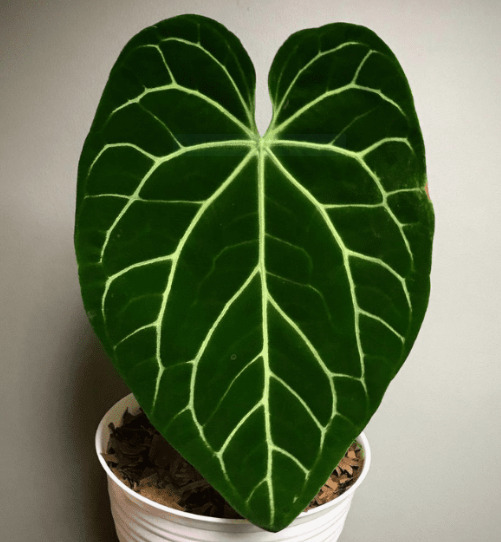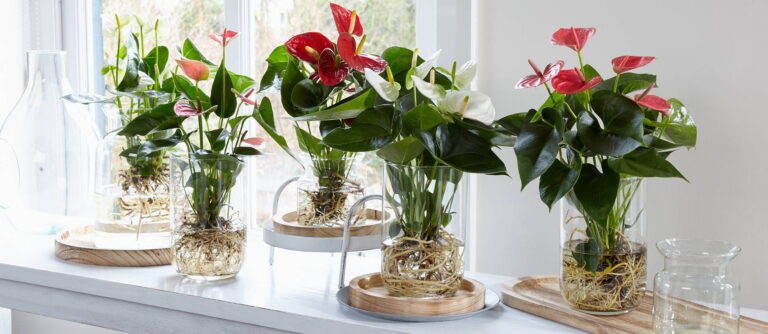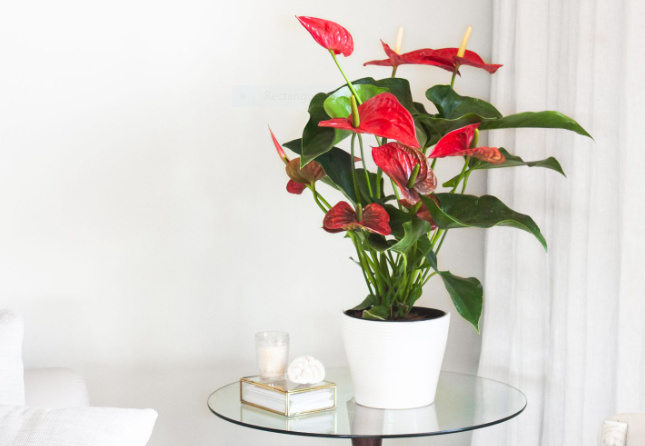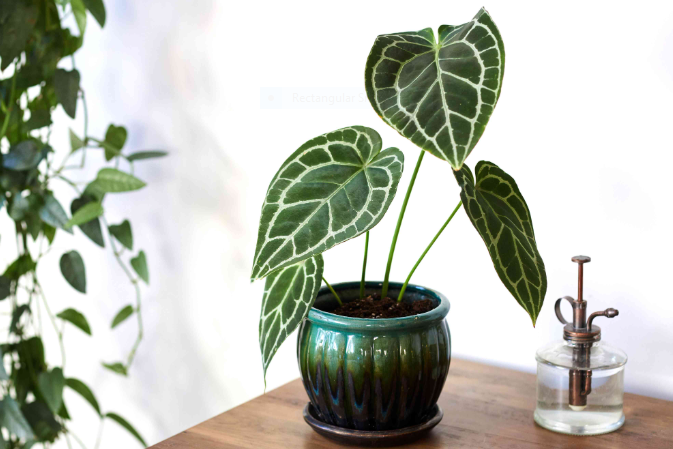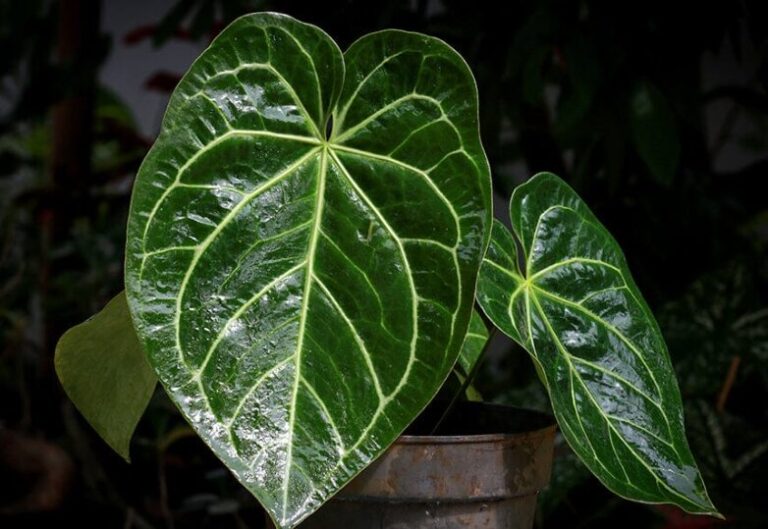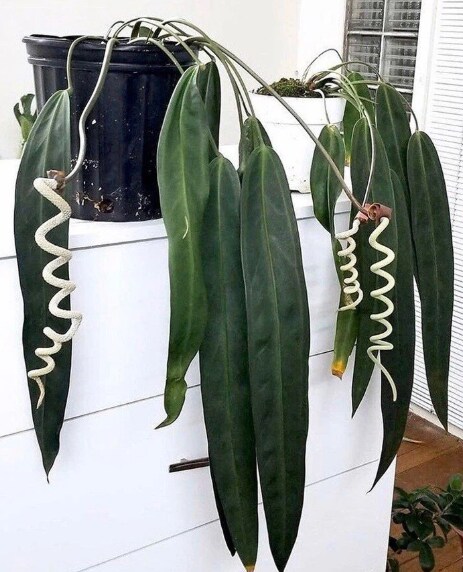Anthurium Veitchii: Origin, Types, Care, and Propagation
Anthurium veitchii, also referred as the King Anthurium, is relatively a rare type of anthuriums. The plant is known for its large, stunningly rippled and oblong leaves. However, this epiphytic plant requires great care when grown indoors.
In this care and growing guide, we will cover everything you require to keep this plant thriving. We will also cover how you can propagate this King Anthurium to produce as many copies as possible.

What is Anthurium Veitchii? Origin & Appearance
Anthurium Veitchii Origin:
Anthurium veitchii, commonly known as king anthurium, is native to tropical rainforests of Colombia. It is an epiphytic plant and get is name for John Veitch, a plant collector in London, who first collected this plant in Europe.
Anthurium Veitchii belongs to Araceae family that also contains aroid such as monster, peace, lily, philodendron, and pothos plants. The plant produces light-pink or cream colored inflorescent flowers with a spathe and spadix when grown under appropriate care.
Appearance Of King Anthurium:
Anthurium Veitchii’s appearance is similar to that of a lily flower. The plant produces light to mid and heavily corrugated green large leaves, and distinct flowers enhance the beauty of the king anthurium.
Its seedlings’ seeds show ribbed appearance and when it matures, its leaves size up and the ribs become more pronounced and leaves much longer. The young leaves are flush orange or rusty in color. New leaves become also floppy and can easily get damaged.
When fully grown, its leaves can reach up to 4-6 feet long. The leaves have coriaceous or leathery texture and are quite thick. A wild Anthurium Veithcii can produce leaves more than double length of a normal plant in several years.
What Are the Different Types of Anthurium Veitchii?
Anthurium veitchii has two major types: narrow form and wide form.
1. Narrow Form Anthurium Veitchii
The narrow form of veitchii has a sleek appearance with long, slender leaves. The veins on narrow form veitchii are too close to each other. This slim plant gives an aesthetic vibe with perfect vertical leaves.
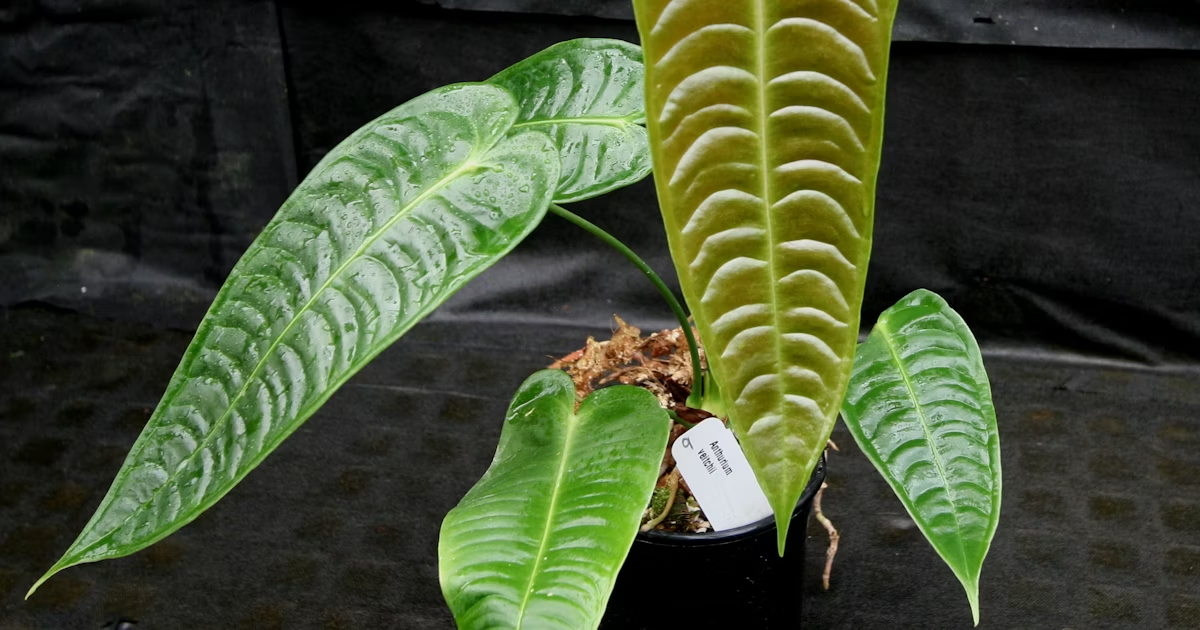
2. Wide Form Anthurium Veitchii
The veins on wide-form veitchii are further apart or spaced out. If you want to create a wild look, this wide-form veitchii is for you.
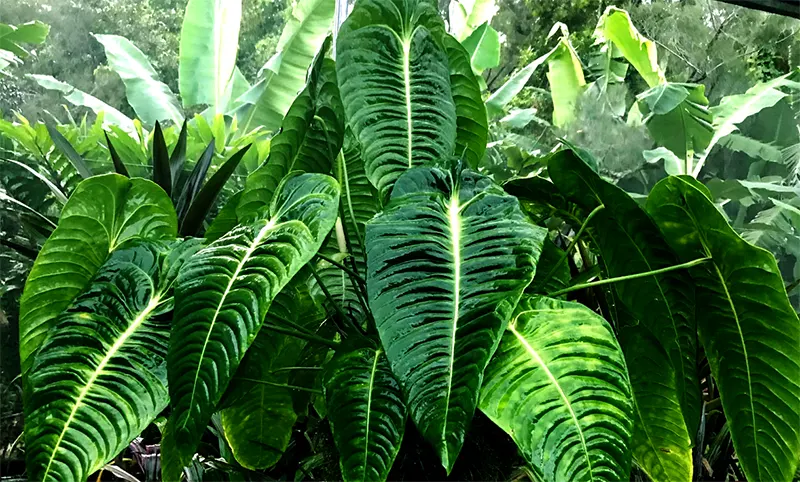
How to Acclimatize Anthurium Veitchii?
Acclimatizing a tropical plant to your growing conditions might be a risk to that plant’s health.
Fluctuations in temperature, shipping stress, and changes in the growing medium affect the plant’s survival. But no worries—some care and tips can help your anthurium veitchii thrive. There are different steps to make your plant happy.
1. Inspect the roots
First, check the plant’s roots. Are they dry, soggy, or juicy? If the plant roots feel dry, grind them all because this can cause rotting. If there is no root rot, place your plant base in a propagation medium such as sphagnum moss, perlite, and orchid bark. If the roots feel healthy, you can move to the next step.
2. Rehydrate
After shipping, check the roots of the King Anthurium. If they feel dehydrated, then remove the plant from the propagation medium. Take a water bowl and place your plant in it for a day. This process will help rehydrate your plant and allow it to thrive again.
3. Potting up
International shipping does not allow pots with plants because of restrictions. Domestic shipment comes potted. After shipment, check the potting medium. If it is suitable, then do not disturb your plant. But if it feels unsuitable, then report it immediately.
Prefer the seller’s growing medium. It will be best for your plant to grow further or thrive in a new environment.
How to Care for Your Anthurium Veitchii Plant? Light, Nutrients, Watering, and Fertilizing
A royal plant requires royal care. Here is how to care for your Anthurium veitchii.
1. Anthurium Veitchii Soil Requirements
The king anthurium loves to grow in a chunky potting medium because it will not suffocate its plant root as plain soil does.
You can choose the right potting mix according to the environmental conditions where you want to grow your plant. That place can be indoors, outdoors, in a cabinet, inside a tent, etc.
In the wild, this plant can quickly grow as an epiphyte on other plants by getting natural nutrients from rain, wind, debris, etc.
You can also make your own potting mix by following Kylee Ellen’s aroid mix recipe.
Take a large bowl and mix:
This DIY recipe is the best for your King Anthurium.
Here are some options for you to make airy soil for better results in your plant growth.
2. Anthurium Veitchii Lighting Requirements
This epiphytic plant grows well in bright, filtered natural sunlight. Always place your plant near an east-facing window that receives filtered light through curtains for indoor growth. If you want to grow outdoors, provide a shed for better results.
For inside, hanging from the ceiling is the best option for growing anthurium veitchii.
Avoid direct sunlight because it can reduce the growth or burn your plant’s leaves.
The north-facing window will not make your plant happy because it will not provide enough light for it to grow well. If this is your only option, you can use a grow light.
3. How Often Should You Water Your Anthurium Veitchii Plant?
Water your king anthurium once a week or when the upper soil layer is dry.
Watering depends on the soil mixture and environmental conditions (where your plant grows). If your plants grow at the best humidity level with chunky soil, they need less watering. However, more watering is required for the best results if they are grown in dry areas.
Do not water if the soil is soggy. Before watering, always check the top inches of the soil. If the upper soil feels dry, then water the plant.
Frequent watering is needed during its growing season, while dormant periods need less watering.
4. Humidity Requirements of King Anthurium
King anthurium prefers high humidity of nearly 60-70 percent to thrive. But too much water on different parts of the leaves is risky for its health.
If conditions are dry, you can raise the humidity levels by:
When humidity gets low, new leaves start ripping when emerging and expanding.
5. Anthurium Veitchii Temperature Requirements
Anthurium veitchii loves to grow in mild, warm temperatures. If you want to grow this plant indoors during winter, the temperature should not decrease from 16- 20 degrees Celsius.
The best temperature range for the king anthurium is between 60°F and 80°F. Avoid placing your plant in cold areas, air conditioners, heaters, and drafty windows.
If the temperature is not suitable, your plant will go dormant and not produce many leaves.
6. Fertilizing Requirements of Your Anthurium Veitchii Plant
Fertilizer is key to keeping your Anthurium Veitchii thriving.
Always fertilize your plant during its growing season. Dormant seasons are not suitable for fertilizing King Anthurium. If you always have proper light around your plant, you can fertilize at any time.
Feed your plant with dilute fertilizer with NPK 9-6 or one with the value 12-12-12, used with every second of watering. Good nutrients encourage the process of flowering in your plant.
Dyna-Gro Grow can also be the best option to fertilize your king anthurium. It contains all the micro and macronutrients for your plant.
7. Potting and Repotting Of Anthurium Veitchii
The King Anthurium grows slowly, so you can repot it after 2-3 years. It will show specific signs for repotting. For example;
When you notice such signs, repot your king anthurium in a pot that is one or two inches larger in diameter than the previous one and contains fresh potting mix.
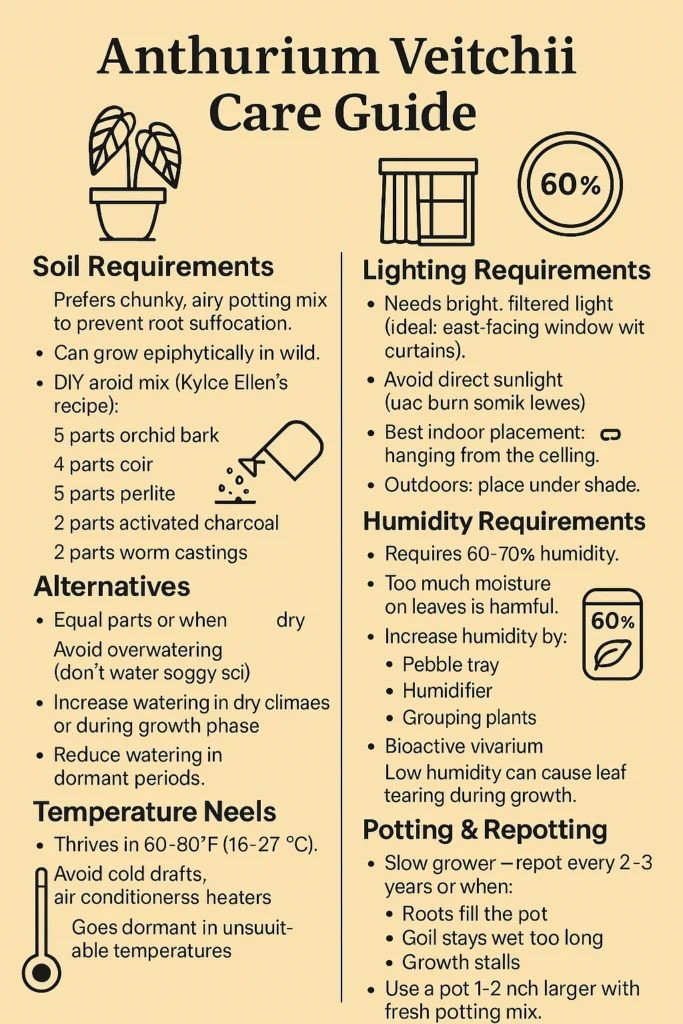
How to Propagate Your Anthurium Veitchii/King Anthurium?
Anthurium Veitchii can be propagated through two methods: Through Separation and Stem Cutting.
1. Propagation Through Separation:
The propagation through separation involves unpotting your veitchii plant and removing the soil from the root balls. After removing the soil, untangle the roots and separate the plants into two or more smaller plants. You can also cut the roots if necessary using a sterilized knife or shears.
Once you have separated the plants, pot them up in their new pots and care for them appropriately.
2. Propagation Through Stem Cutting
Anthurium Veitchii’s propagation through stem cutting involves the following steps:

How to Grow Anthurium Veitchii from Seeds?
Growing Anthurium Veitchii from seeds involves the following steps:
Common Pest Attacks and Plant Diseases of Anthurium Veitchii
Common houseplant pests, including mealybugs, spider mites, aphids, fungus, gnats, whiteflies, and scale, can attack your King Anthurium. Inspect your plant regularly for pest attacks and treat the infestation using neem oil and other sprays.
Your plant can also become dull due to diseases like bacterial blight. In this disease, the leaves become yellow and produce V-shaped areas along the margins. Similarly, fungal pathogens can also affect its roots.
To prevent these diseases and keep your plant thriving, avoid overwatering and maintain air circulation in warm temperatures.
Common Problems with Anthurium Veitchii
Your Anthurium Veitchii can face the following common problems:
1. Yellowing Leaves:
The yellowing leaves, accompanied by black or slimy roots of your King anthurium, can be due to overwatering:
Solution: Hold off watering and let the soil dry. Sometimes, repotting it fresh soil and pruning dead or damaged areas can also be the great solution.
2. Brown Spots on the Leaves:
Exposure to too much direct light can produce dry brown spots on the leaves of your King Anthurium.
Solution: Use shear curtains or move your plant away from the light source.
3. Browning Tips:
Exposure to too much light and a lack of water can produce browning tips on your Anthurium Veitchii plant.
Solution:
Adjust the soil moisture and lighting conditions appropriately.
Also Check What is Anthurium Hookeri?
FAQS
Is Anthurium Veitchii toxic or not?
Yes, anthurium veitchii is also toxic for your pets and children because it contains calcium oxalate crystals like other anthuriums.
What are the common pests and diseases that attack King Anthurium?
Aphids, spider mites, and mealybugs commonly attack king anthurium. In this case, use neem oil for protection and avoid overwatering, which can cause fungal infection.
How do I prune my Anthurium Veitchii?
Remove dead and yellow leaves from your plant with the help of scissors. Pruning promotes healthy growth.
Conclusion
Anthurium Veitchii, aka King Anthurium, requires intense care when grown indoors. With proper watering, enough light, humidity, and blended soil, you can keep your Anthurium plant thriving.
Your plant can also be susceptible to pest and disease attacks. Similarly, overwatering, fungal attack, and exposure to direct light can also cause your plant to produce yellow leaves, brown spots, and browning tips. Adjust watering and light conditions to keep it thriving.

About Author
Hi, I’m Emily Davis, a passionate tropical plant enthusiast dedicated to sharing knowledge and expertise with plant lovers. Through his blog, I will provide guides, tips, and tricks for caring for tropical houseplants species like Alocasia, Anthurium, Calathea, Philodendron, Begonia, and many more that will help readers bring a touch of paradise into their own homes. With a deep love for the vibrant colors and lush textures of tropical flora, I’m committed to inspiring others to cultivate their own tropical oasis.

